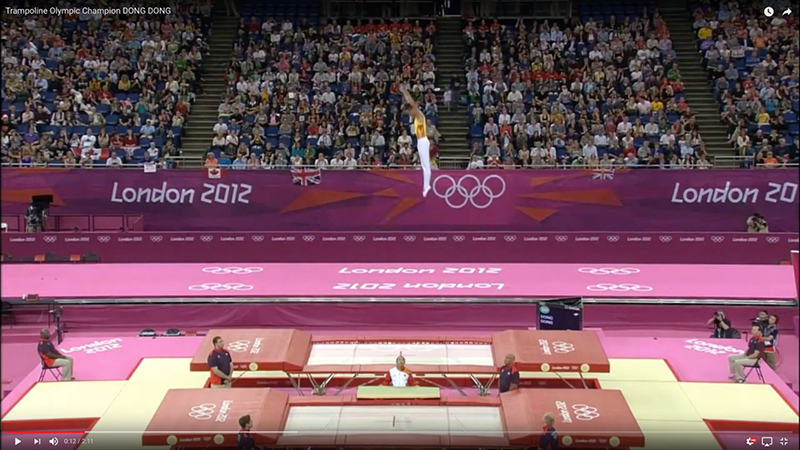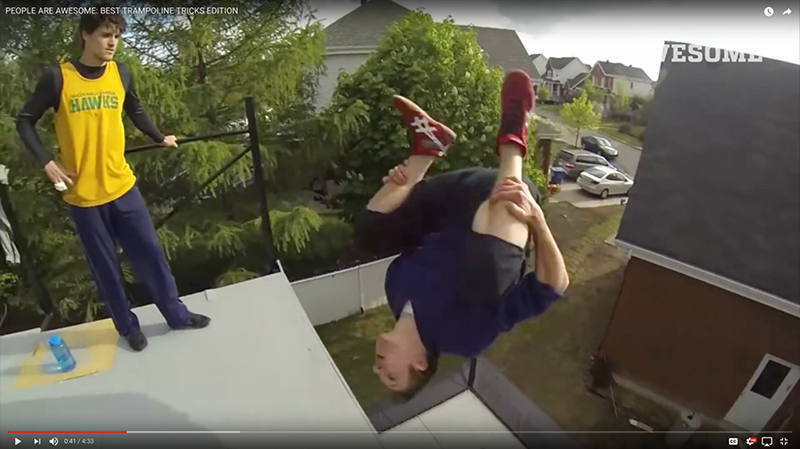Boing

The trampoline is really, really fun!! Professionals and the rest of us can have a ball with it. There’s that cool Nike Zoom Vaporfly. Read on, friends. And check out the amazing video links in this week’s story.
I was reading an article the other day about recent marathon results, and specifically about the new Nike running shoe, called the Zoom Vaporfly. The popular pink shoe features carbon plates and springy midsole foam and has become an explosive battle among runners (get it?). The biggest issue for professional and amateur racers alike is the debate whether the shoes save so much energy that they amount to an unfair advantage, granted every time I read or see a news clip about these shoes I immediately think of Disney’s FLUBBER! A study by the NYTimes found that a runner wearing the most popular versions of these shoes (available to the public) – the Zoom Vaporfly% or ZoomX Vaporfly Next% – ran 4 to 5 percent faster than a runner wearing an average shoe, and 2 to 3 percent faster than runners in the next-fastest popular shoe. The shoes, which retail for $250, (out of my price range) confer an advantage on all kinds of runners: men and women, fast runners and slower ones, hobbyists and frequent racers. Since its release in 2017, Nike’s Vaporfly racing shoe has rewritten the record books – the five fastest men’s marathons ever, four of the 10 fastest women’s marathons, and 31 of 36 podium spots in the 2019 World Marathon Majors have all been won using the shoes. It got me to thinking about energy and bounce, and of course led me to Mr. Charles Nissen, an inventor and gymnast from Cedar Rapids Iowa who invented the first modern trampoline – patented on this day of March 1945. (bet you didn’t expect this story to bounce this way (get it again?). So, for all my exercise buds basement bouncers and back yard flippers, here’s some fun history. Special thanks to the NYTimes and Wikipedia for the insights and info. Enjoy!
A trampoline is a device consisting of a piece of taut, strong fabric stretched between a steel frame using many coiled springs. Not all trampolines have springs, as the Springfree Trampoline uses glass-reinforced plastic rods. Most people bounce on trampolines for recreational and competitive purpose.
The fabric that users bounce on, commonly known as the “bounce mat” or “trampoline bed”, is not elastic itself; the elasticity is provided by the springs that connect it to the frame, which store potential energy.
A game similar to trampolining was developed by the Inuit, who would toss blanket dancers high into the air on a walrus skin one at a time during a spring celebration of whale harvest. (not sure, but for some reason, this makes sense to me). There is also some evidence of people in Europe having been tossed into the air by a number of people holding a blanket – known as “blanketing”. My guess is lots of beir was involved at the time!
The trampoline-like life nets once used by firefighters to catch people jumping out of burning buildings were invented in 1887 by Thomas F Browder from Greene County, OH. A life net, also known as a Browder Life Safety Net, is a type of rescue equipment formerly used by firefighters. When used in the proper conditions, it allowed people on upper floors of burning buildings an opportunity to jump to safety, usually to ground level. The device was used with varying degrees of success during several notable fires in the 20th century but became obsolete by the 1980s.
According to circus folklore, the trampoline was supposedly first developed by an artiste named du Trampolin, who saw the possibility of using the trapeze safety net as a form of propulsion and landing device and experimented with different systems of suspension, eventually reducing the net to a practical size. While trampoline-like devices were used for shows and in the circus, the story of du Trampolin is almost certainly apocryphal as no documentary evidence has been found to support it. (the circus is famous for making things up).
The first modern trampoline was built by George Nissen and Larry Griswold in 1936. Nissen was a gymnastics and diving competitor and Griswold was a tumbler on the gymnastics team, both at the University of Iowa. They had observed trapeze artists using a tight net to add entertainment value to their performance and experimented by stretching a piece of canvas, in which they had inserted grommets along each side, to an angle iron frame by means of coiled springs.
Nissen explained that the name came from the Spanish trampolín, meaning a diving board, saying he had heard the word on a demonstration tour in Mexico in the late 1930s and decided to use an anglicized form as the trademark for the apparatus.
In 1942, Griswold and Nissen created the Griswold-Nissen Trampoline & Tumbling Company, and began making trampolines commercially in Cedar Rapids, Iowa.
The generic term for the trademarked trampoline was a rebound tumbler and the sport began as rebound tumbling. It has since lost its trademark and has become a generic trademark.
Early in their development Nissen anticipated trampolines being used in a number of recreational areas, including those involving more than one participant on the same trampoline. One such game was Spaceball—a game of two teams of two on a single trampoline with specially constructed end “walls” and a middle “wall” through which a ball could be propelled to hit a target on the other side’s end wall.
During World War II, the US Navy Flight School developed the use of the trampoline in its training of pilots and navigators, giving them concentrated practice in spatial orientation that had not been possible before. After the war, the development of the space flight program again brought the trampoline into use to help train both American and Soviet astronauts, giving them experience of variable body positions in flight.
The first Trampoline World Championships were organized by Ted Blake of Nissen and held in London in 1964. The first World Champions were both American, Dan Millman and Judy Wills Cline. Cline went on to dominate and become the most highly decorated trampoline champion of all time.
One of the earliest pioneers of trampoline as a competitive sport was Jeff Hennessy, a coach at the University of Louisiana at Lafayette. Hennessy also coached the US trampoline team, producing more world champions than any other person. Among his world champions was his daughter, Leigh Hennessy. Both Jeff and Leigh Hennessy are in the USA Gymnastics Hall of Fame.
The competitive gymnastic sport of trampolining has been part of the Olympic Games since 2000. On a modern competitive trampoline, a skilled athlete can bounce to a height of up to 33 ft, (think three stories high) performing multiple somersaults and twists. Trampolines also feature in the competitive sport of Slamball, a variant of basketball, and Bossaball, a variant of volleyball. check out this Olympian

Recreational trampolines, also known as bounce mats, are for home use and are less sturdily constructed than competitive ones and their springs are weaker. They may be of various shapes, though most are circular, octagonal or rectangular. The fabric is usually a waterproof canvas or woven polypropylene material. As with competitive trampolines, recreational trampolines are usually made using coiled steel springs to provide the rebounding force, but spring-free trampolines also exist. check out this amazing video

In 1959 and 1960 it became very popular to have outdoor commercial “jump centres” or “trampoline parks” in many places in North America where people could enjoy recreational trampolining. Here are some amazing guys having fun outside

In the early 21st century, indoor commercial trampoline parks have made a comeback, with a number of franchises operating across the United States and Canada. ABC News reported in 2014 there were at least 345 trampoline parks operating in the US. These commercial parks are located indoors and have wall-to wall-trampolines to prevent people falling off the trampolines on to hard surfaces. Padded or spring walls protect people from impact injuries.
Wall running is a sport where the participant uses a wall and platforms placed next to the trampoline bed to do tricks. The basic movement is a backdrop on the trampoline and then the feet touching the wall at the top of the bounce. From there, there is no limit to the acrobatic movements that are possible, similar to regular trampolining.
::::::::::::::::::::::::::::::::::::::::::::::::::::::::::::::::::::::::::::::::::::::::::
DO YOU LIKE CONTESTS?
Me, too.
As you may know the Kowalski Heat Treating logo finds its way into the visuals of my Friday posts.
I. Love. My. Logo.
One week there could be three logos. The next week there could be 15 logos. And sometimes the logo is very small or just a partial logo showing. But there are always logos in some of the pictures.
So, I challenge you, my beloved readers, to count them and send me a quick email with the total number of logos in the Friday post. On the following Tuesday I’ll pick a winner from the correct answers and send that lucky person some great KHT swag.
So, start counting and good luck! Oh, and the logos at the very top header don’t count. Just in the pictures area. Got it? Good. :-)))) Have fun!!
::::::::::::::::::::::::::::::::::::::::::::::::::::::::::::::::::::::::::::::::::::::::::



Leave a Reply
Want to join the discussion?Feel free to contribute!